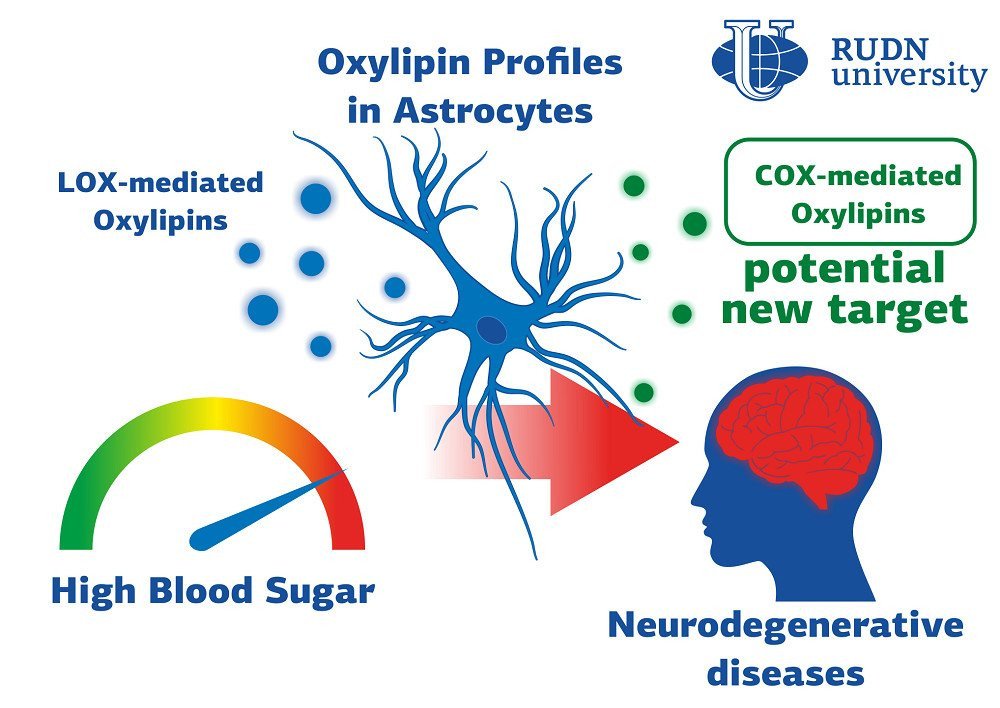Chemist Finds New Target For the Treatment of Neurodegenerative Consequences of High Blood Sugar

High blood sugar (hyperglycemia) can cause cognitive impairment, epilepsy and other neurodegenerative disorders. The main form of glucose storage in the body is glycogen. In the brain, it is stored mainly in nerve cells, astrocytes, which are formed from various polyunsaturated fatty acids. They “communicate” with each other, releasing signalling molecules — oxylipins. Until now, it was not known what happens to oxylipins when glucose levels increase. Chemists from the RUDN University and MSU have studied how hyperglycemia affects oxylipins and proposed a new therapeutic target for the treatment of brain disorders associated with hyperglycemia.
“Hyperglycemia is associated with several complications in the brain. igh glucose exposure causes astrocyte dysregulation, but its effects on the metabolism of oxylipins are relatively unknown and therefore, constituted the focus of our work”, said Sergey Goriainov, the Head of the Laboratory of Mass Spectrometry and High-resolution NMR Spectroscopy of RUDN’s Center for Collective Use.
To compare how the oxylipin profiles in the astrocytes change with different glucose levels, scientists took astrocytes from the brain of rats and placed them in an environment with normal (5.5 mmol) and high (25 mmol) glucose concentration. The biochemists then measured the profile of oxylipins using a high-performance liquid chromatography-mass spectrometer UPLC-MS/MS. Oxylipins were divided into two groups, depending on by which enzymes they were derived from their predecessors — polyunsaturated fatty acids. Then they statistically analyzed the data.
It turned out that with high glucose, the profile of oxylipins released by astrocytes changes. In an environment with a high concentration of glucose, there were about four times more oxylipins, which were obtained by cyclooxygenase (COX). At normal sugar levels, COX-oxylipins were about five picograms per milligram, and about 20at high levels. For comparison, the level of oxylipins, derived by another enzyme (lipoxygenase, LOX), hardly changed depending on the glucose level and remained at 1-3 picograms per milligram. Scientists have concluded that COX-oxylipins may become a new direction for the treatment of brain disorders that occur due to hyperglycemia.
“The data suppose a regulation of COX-mediated oxylipin synthesis as a potential new target in the treatment of brain impairment associated with hyperglycemia”, said Sergey Goriainov, the Head of the Laboratory of Mass Spectrometry and High-resolution NMR Spectroscopy of RUDN’s Center for Collective Use.
The results are published in Metabolites.
RUDN summarized the results of the scientific competition "Project Start: work of the science club ". Students of the Faculty of Physics, Mathematics and Natural Sciences have created a project for a managed queuing system using a neural network to redistribute resources between 5G segments. How to increase flexibility, make the network fast and inexpensive and reach more users — tell Gebrial Ibram Esam Zekri ("Fundamental Computer Science and Information Technology", Master's degree, II course) and Ksenia Leontieva ("Applied Mathematics and Computer Science", Master's degree, I course).
The National Demographic Report, 2023 Demographic Well-Being of Russian Regions (hereinafter - the National Demographic Report) was prepared by the scientific team of the Institute of Demographic Studies of the Federal Research Center of the Russian Academy of Sciences, the Vologda Scientific Center of the Russian Academy of Sciences, Peoples' Friendship University of Russia, the Center for Family and Demography of the Academy of Sciences of the Republic of Tatarstan, as well as with the participation of leading scientists from the Republic of Bashkortostan, Stavropol Krai, Volgograd, Ivanovo, Kaliningrad, Nizhny Novgorod, Sverdlovsk Oblasts and Khanty-Mansi Autonomous Okrug–Yugra.
RUDN summarized the results of the scientific competition "Project Start: work of the science club ". Students of the Faculty of Physics, Mathematics and Natural Sciences have created a project for a managed queuing system using a neural network to redistribute resources between 5G segments. How to increase flexibility, make the network fast and inexpensive and reach more users — tell Gebrial Ibram Esam Zekri ("Fundamental Computer Science and Information Technology", Master's degree, II course) and Ksenia Leontieva ("Applied Mathematics and Computer Science", Master's degree, I course).
What is your first association with the word “laboratory”? Flasks and beakers? Microscopes and centrifuges? Yes, many of us would answer the same way.
The National Demographic Report, 2023 Demographic Well-Being of Russian Regions (hereinafter - the National Demographic Report) was prepared by the scientific team of the Institute of Demographic Studies of the Federal Research Center of the Russian Academy of Sciences, the Vologda Scientific Center of the Russian Academy of Sciences, Peoples' Friendship University of Russia, the Center for Family and Demography of the Academy of Sciences of the Republic of Tatarstan, as well as with the participation of leading scientists from the Republic of Bashkortostan, Stavropol Krai, Volgograd, Ivanovo, Kaliningrad, Nizhny Novgorod, Sverdlovsk Oblasts and Khanty-Mansi Autonomous Okrug–Yugra.